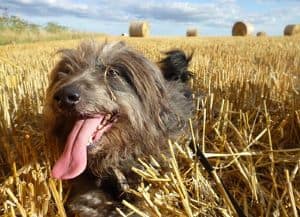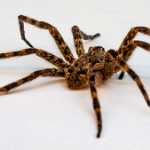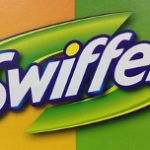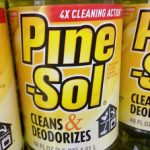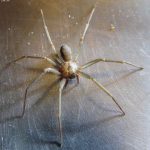Keeping an outdoor dog kennel warm, especially in very cold weather, can be a challenge for many pet parents.
And if you have genuine concerns on how to properly insulate your dog house with something inexpensive and easy to get, then you must have thought of straw.
But you’re also concerned about how safe straw is for dogs, right?
Well, you should know that straw has been used as bedding for animals for centuries now, and it’s still used today.
Since straw is the dry stalk of grain crops, there are different types and not all of them are safe for dogs.
There are certain straw types that are safe for dogs and work great as dog bedding. If you’re considering the use of straw for bedding in your outdoor kennel, read on to find out all you need to know about straw bedding for your canine friend.
Is straw good for a dog house?
Straw is a relatively good bedding for an outdoor dog kennel, it can be spread in the doghouse to about 5 inches thick to provide enough warmth and insulation.
However, using straw for bedding requires great care and caution.
First, the straw should be from a reputable source, since these are farm by-products they can contain parasites and bacteria if not handled properly.
Straw from a good source can be a good bedding choice for your dog kennel. When used as bedding, straw should be changed at least once a week.
Straw can be used with a dog blanket to make a better insulated and comfortable bedding.
In this case, the straw is evenly spread on the floor to a thickness of about 5 inches, and a dog blanket is then spread over the straw to make a soft, comfortable and warm bed.
Four types of straw used for dog bedding
Straw is basically the dry stalk of cereal plants such as barley, wheat, rye, rice, oat, sorghum, etc. There are many types of straw depending on the cereal crop it’s made from, and not every one of them is used for bedding. Here are the most common straw bedding options.
Wheat Straw: this is one of the most common types of straw bedding used for both livestock and outdoor dog bedding. Although it’s the dustiest straw, it also tends to be really warm and doesn’t flatten very quickly. Wheat straw is also not a good absorbent, but it’s relatively easy to handle.
Barley Straw: Barley straw is one of the cheapest types of straw you’ll find, but it doesn’t make a great bedding for dogs. It’s also not a suitable bedding for other livestock including horses. This is because barley straw bedding causes intense skin irritation because of the long prickly awns of the ear of barley.
Oat Straw: this is another high quality straw for bedding livestock, it’s softer and more absorbent than wheat straw. But it isn’t quite a good choice for dogs because just like barley it has the tendency to cause itchiness in dogs. Besides this concern, oat straw is also pretty expensive because it has value as horse and cattle fodder.
Pine straw: this is one of the most acceptable straw bedding options for an outdoor dog kennel. Pine straw is safe and comfortable for dogs, but it’s a very poor absorbent therefore it has to be changed quite often.
Is straw bad for dogs to eat?
One of the favourite pastime activities for dogs is chewing. Some dogs simply can’t go a day without chewing, and this is seen more often in young dogs who are still growing and exploring their environment.
These dogs have a lot of energy to expend and will do almost anything for fun. If you have a bored dog in a kennel with straw bedding, chances are they will curiously chew on the straw to entertain themselves. Dogs eat grass, chew on plaster and basically anything else they find interesting, and if their straw bedding makes it to their list of interesting things to chew on, you really can’t stop them.
A little straw may not hurt your dog, but a lot of it certainly will. Too much straw in your dog’s system may cause digestive distress or increase the risk of intestinal blockage. If your dog chews straw all the time, this may be a sign that they need more exercise and fun activities included in their daily routine.
You can try to get them to exercise more to help them expend some energy, or give them a chew toy or raw bones to chew on. If you want a permanent fix, then simply get rid of the straw bedding and replace it with something they will be less interested in.
Hay vs straw, which is better for a dog house?
While straw is the dry stalk of grains and cereal crops, hay is grass that has been cut and dried. Both straw and hay can be used for dog house bedding, but they have different properties which affects how well they perform. Straw is yellow, dry and long hollow tube, it tends to be a poor absorbent, brittle and easily breaks down to straw dust.
Hay, on the other hand, is the long slender stem of grasses that have been dried. Compared to straw, hay is a better absorbent and retains its structure for much longer. It’s not brittle and therefore doesn’t break down to form dust. Hay also beds down softer and better than straw, long stem grass hay is an excellent bedding for dog house.
Hay is certainly a better bedding than straw, because straw doesn’t bed down well and as a dog moves around in the kennel, the straw bedding is pushed from side to side. When used as bedding, hay lasts longer and provides better insulation for dogs. But because it retains more water than straw, it also has the tendency to become wet making it unpleasant for the dog which is why it should be changed frequently.
Dog bedding generally has to be changed as often as possible to ensure that your dog always has a comfortable and cosy nest with enough warmth. Straw should be changed at least once a week, but hay bedding can last a little longer.
Is hay harmful to dogs?
Hay is a good choice for outdoor dog bedding, it provides a warm and cosy bed for your dog. Hay is also inexpensive and environmentally safe, long stem grass hay is especially great for dog bedding.
But, remember that dead plant materials have the potential to effectively harbour microorganisms including harmful bacteria and parasites that can cause serious infectious diseases in dogs.
If you intend to use hay for bedding your dog, make sure that you get high-quality hay from a good source and replace the bedding as frequently as possible. It’s important to never let your dog lay on wet bedding because this will expose him/her to cold which is unhealthy.
Also, wet hay will encourage the rapid growth of microorganisms, hay can become mouldy which has severe health implications. Hay can also cause digestive distress if ingested in large quantities by your dog. Although hay makes good bedding for an outdoor dog kennel, it does have some drawbacks and has to be managed with great care.
Other outdoor dog kennel bedding options
Besides straw and hay, there are other materials that are suitable for making a warm and comfortable bed for your outdoor dog kennel, and these include wood chips and shavings usually made from either cedar or pine. Wood chips are made from small chunks of cedar or pine while the shavings are made from finer pieces of wood.
Thin wood shavings are better because they bed down better and provide a more comfortable bed for your dog. Cedar chips are also not a good choice if you have puppies who love to chew, because they will chew the small wood chips which can cause digestive distress or blockage.
Cedar bedding for dogs
Cedar shavings are excellent bedding for dog house for a number of reasons. It provides a comfortable and well-insulated bed for your dog. But the best part of using cedar is the smell which is an effective insect repellant and deodorant.
Unfortunately, this is also the major drawback to using cedar chips. The strong smell of cedar can cause allergic reactions in dogs with respiratory problems, therefore it should never be used as bedding for dogs with allergies. Avoid cedar bedding if your dog has allergies of any kind.
Pine shavings for dogs
This is a great option for dog houses because it’s comfortable, warm, and it’s a fairly good absorbent and also dries out quickly. Like, cedar, pine shaving acts as a natural deodorizer, keeping bad smell and insect pests at bay. Quality pine shaving purchased from a reputable company will have no bacteria or parasites present.
What is the best bedding for dogs?
The best bedding for dogs should neither be too soft nor too firm. Too firm or too soft bedding can be uncomfortable for dogs, and they may develop joint problems and body aches. If your dog is stiff every morning or after hours of sleep, then their bedding may be uncomfortable and is causing them some discomfort.
The best bedding for dogs is a good dog bed with an orthopaedic mattress, this is best used indoors, but there are some good dog beds designed for outdoor use. The best dog beds should be at least 5 inches thick with a layer of memory foam and orthopaedic mattress. There are some dog beds that are elevated with a waterproof canopy for added protection. Whether you have an indoor or outdoor dog, it’s possible to find an excellent and durable dog bed to satisfy your dog’s needs.
Wrapping up
When used for bedding in an outdoor dog kennel, straw will keep your dog warm and comfortable. Straw is generally safe for dogs but should be changed very often because they tend to break down very quickly. Hay is also a good bedding for the dog house, both straw and hay should be sourced from a reputable farm to avoid exposing your dog to contaminated farm by-products that can cause some serious infectious disease. Other good options for warm and comfortable dog house bedding include wood chips and shavings from cedar or pine.

